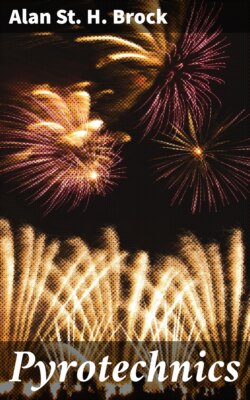Читать книгу Pyrotechnics - Alan St. H. Brock - Страница 5
На сайте Литреса книга снята с продажи.
CHAPTER I
THE ORIGIN OF PYROTECHNY
ОглавлениеTable of Contents
Pyrotechny, or the Art of Firework-making, is of great antiquity, and the date of its origin is quite unknown; indeed, it would be impossible to define with any degree of exactitude what actually constitutes a firework.
It is curious how universal is the belief that fireworks were dependent upon the invention or discovery of gunpowder. Very little consideration will prove the fallacy of this view; in fact, will show that the reverse is probably the case. In India and China saltpetre (or nitrate of potash) is found in large quantities, and was, no doubt, used by the primitive inhabitants in far-off times for such purposes as curing meat, cooking, etc. The dropping of a quantity in the camp fire may have attracted the attention of some early inventor to the extent of starting him on a series of what were probably the earliest chemical experiments.
He would notice that the presence of saltpetre made the fire burn brighter, and its use as a tinder maker would suggest itself by mixing it with some substance which he knew to be combustible. The most common fuel he knew of was wood, but it must be a powder to mix evenly with saltpetre. Wood is not easily reduced to powder; saws had not been invented, so that he could not add sawdust, and the nearest thing he could get would be charcoal from the fire, which could easily be reduced to powder. With this mixture he would be well on the way to success in elementary pyrotechny.
The next step in his career as the first pyrotechnist is to utilise his composition as an easy means of making fire. Gradually he gives up his hitherto necessary tasks of hunting and trapping, as he receives the fruits of other labours in return for his services as fire-maker to the tribe.
The most important item in early social life is fire, the implements for producing it the most valued property of the tribe; it was the focus of religion and the centre of daily existence, so that any new phenomenon connected with fire would be of the greatest interest to primitive people, and any short cut to the production of fire would be accorded more perseverance and care in its perfection than almost any other invention.
Fire would be struck with a piece of iron pyrites on a flint, small pieces of reguline particles of iron would be detached and fall on the fire mixture unlit. Afterwards, when combustion of the mass of fire mixture took place, these small pieces of metal would scintillate as do the iron filings in a modern firework composition. This would give rise to a further series of experiments, and gradually the composition known as Chinese Fire would be evolved, which is known to have been in use in the East from remote times.
Having arrived at a pyrotechnic composition, attempt to use it in other ways besides fire-making would naturally follow, and sooner or later the idea of filling the mixture into tubes would suggest itself, especially as both in India and China (in one of which countries pyrotechny undoubtedly originated) a serviceable tube—or to use the modern term “case”—was ready to hand in any size or quantity in the ubiquitous bamboo. The bamboo is in use for the purpose at the present day in the East, and until recent times, when displaced by European weapons, was used in the construction of ordnance of considerable size. Mortars used for throwing firework shell up to six or more inches in diameter are still in use in Japan and China, the barrel consisting of a section of bamboo strengthened on the outside with a binding of split cane.
Having reached the point of charging composition into a tube, that is to say confining it, a more or less violent explosion was likely or rather certain to follow during the course of the experiments, which might suggest the use of a tube as a means of discharging a projectile. This would lead to research in the direction of the best composition for the purpose and the evolution of gunpowder.
It must be remembered that the constituents of gunpowder must be present in approximately exact proportion, whereas with primitive pyrotechnic compositions, if the ingredients saltpetre and charcoal are present, it is almost impossible to fail in getting some result.
The above suggestion must not be taken literally as a statement of fact, but rather as an attempt on the part of the writer to trace the stages by which pyrotechnic and explosive compositions came to be evolved.
If one disabuses one’s mind of the curiously widespread belief that all fireworks are composed chiefly of gunpowder, and that without the invention of gunpowder fireworks could not have been constructed, it seems far more likely that pyrotechny is based on the discovery of the assistance given to combustion by saltpetre, than on the discovery of gunpowder.
